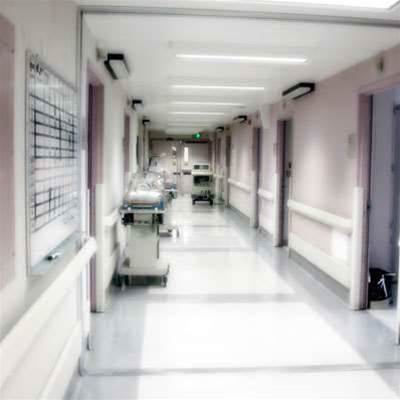St Vincent’s Health Australia (SVHA) has set up a new enterprise-wide system to record, manage, and analyse data about incidents involving patients, clients, and residents across their hospitals, aged care facilities, and services nationwide.

Manager of clinical governance informatics, Edel Murray, told the iTnews Podcast that the application, called SVHA Riskman, replaced five previous instances of a system formerly known as just ‘Riskman’.
“Historically, St. Vincent's was divided into different divisions, and each of those divisions had a different instance of Riskman, depending on what they were using it for. When we came together as a larger, broader organisation, we wanted to be able to look at safety and quality data right across the organisation, and to share learnings,” Murray explained.
“If one particular area was performing really well, then what were they doing that might be different to another area of the organisation? We just could not do that with the five different instances.”
SVHA is Australia’s largest not-for-profit health and aged care provider, operating three public hospitals, 10 private hospitals and 23 aged care facilities, along with three co-located research institutes.
The SVHA Riskman application is now used by around 24,000 staff at these sites, as well as by central functions such as clinical governance and assurance for risk management, regulatory compliance, and related purposes.
Reporting and oversight
When Riskman comprised five separate instances, there was no standardised data set, so similar data could be recorded in five different ways, using different definitions and data elements.
Some instances could not support emerging data collection requirements, and the amount of data that could be collected depended on how new the instance was.
That created a visibility and reporting headache for management teams, and central units such as clinical governance and assurance.
“Our teams were taking a long time to do basic data entry and reporting. Resourcing was being spent trying to data capture, rather than reviewing and prioritising the data for continuous improvement,” Murray said.
“As an organisation, we were spending a lot of time correlating and mapping data to ensure that we were meeting our jurisdictional, legislated, and internal reporting requirements, and to easily use that data to inform quality improvement activities across the organisation.
"Our SVHA managers also needed to access multiple systems and applications to get the data they needed.
“Giving them a single application where they could perform multiple tasks - from exploring data on ‘near misses’, to checking the status of improvement activities for their facility - became a large driver for the SVHA Riskman project.”
Re-architecting SVHA Riskman
The first part of standing up SVHA Riskman involved engaging with stakeholders, mapping current to future state processes, standardising and establishing baseline types of data that needed to be collected at site, and understanding definitions for that data.
“We focused on what was common to the teams rather than what was very different,” Murray explained.
“Given it has operations in multiple states, different pieces of data had to be collected to meet requirements that vary state-to-state. In these circumstances, SVHA Riskman is designed to recognise where a user is based, and to tailor the data it asks based on their location.
“We worked very closely with our Digital and Technology team so that if you're a user from Victoria, or you work in our acute care hospitals, you would see extra questions that are specific to your location and facility."
The SVHA Riskman application itself is an RLDatix product. A third party vendor, alongside the RLDatix team and SVHA’s Digital and Technology teams, partnered with the business to implement the application, so it could be accessed from every single computer across St Vincent’s.
It will soon be available through a mobile app, too. This will introduce additional benefits, such as improved utility for staff that move between SVHA sites, and mobile capture of particular hazards.
“If you're one of our senior executives, and you've come to one of our facilities and identified a hazard, you won’t need a computer in front of you,” Murray said.
“Instead, you can quickly load the hazard up on your electronic device and give the basic information to our teams. SVHA Riskman will then alert the manager of that area, so they know that the hazard is there, and can start to do something about it. This will also alert our work health and safety teams.”
The SVHA Riskman application also means recall notices by the Therapeutic Goods Administration (TGA) can be captured as soon as they are received, and instantly shared across sites.
“Historically, these TGA notices can go to many different people across the organisation,” Edel said.
“Now, the first person who receives this TGA notification can log it in the system. It alerts the local teams, plus any groups across our divisions. This can all be managed directly in the system, so we know that we've safely executed that recall, whereas historically, there was a lot of communication that had to occur via emails, phone calls and follow-ups.”
For Murray’s team in clinical governance and assurance, SVHA Riskman offers a step-change in keeping track of risks and incidents across SVHA’s operations.
“We, at any time, can look in our system and see the number of patient, client, and resident events that occur in a particular organisation,” she said.
“We can see the severity, we can see where we've had to commence investigations, and understand what sort of actions and recommendations need to take place. It also allows us to watch for trends across the whole of SVHA.”
In the last six months alone, over 36,000 events - incorporating incidents, hazards, and general feedback - were managed through SVHA Riskman, allowing the clinical governance teams to analyse consistent themes across their sites.
New data warehouse
The work that Murray and the extended project team put into SVHA Riskman has also streamlined the path for other data-driven initiatives.
The Digital and Technology team is currently working on a program called ‘Fast Track Analytics’, which will consolidate data from across SVHA into a single data warehouse, where it can be analysed and displayed via dashboards.
“The SVHA Riskman data is landing into our warehouse with a lot of other data, and this will give us some new, and exciting insights into the activities we're doing across SVHA,” Murray explained.
“If we had not done this standardisation and consolidation project for SVHA Riskman, our Digital and Technology teams would have to go to five different versions of Riskman, and then map the data to try and get it into the data warehouse. Now we can bring it all in and land it together.”
Murray is hopeful the ability to correlate with different data sets outside of SVHA Riskman will lead to better understanding of patient safety, and concrete improvement actions.
“The big thing for us is to have the right data in the right hands, so our teams can make really important decisions there and then, to support our staff, patients, and their families.”
Subscribe to The iTnews Podcast at Apple Podcasts, Google Podcasts, Spotify, Amazon Podcasts or wherever else good podcasts are found. New episodes will be released every Monday.




.jpg&h=140&w=231&c=1&s=0)
.png&h=140&w=231&c=1&s=0)

.jpg&h=140&w=231&c=1&s=0)








.jpeg&h=271&w=480&c=1&s=1)








